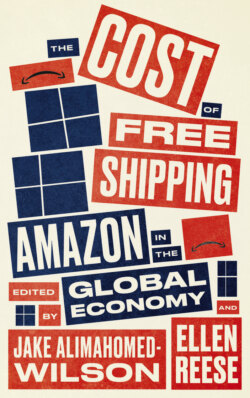Читать книгу The Cost of Free Shipping - Группа авторов - Страница 19
На сайте Литреса книга снята с продажи.
1 Amazon: Context, Structure and Vulnerability Kim Moody
ОглавлениеAmazon the corporate chameleon claims to be the world’s largest online retailer. According to CEO and founder Jeff Bezos, it is actually a tech company.1 While it is both of these, New York University business school analyst Scott Galloway notes that “Amazon is building the most robust logistics infrastructure in history.”2 Two business consultants in their analysis of Amazon concluded that as it entered its third decade, “Amazon is already a major global logistics player.”3 The U.S. trucking industry journal Transport Topics more recently asked “Should Amazon.com be considered one of the largest logistics companies in North America? The answer, according to most industry observers,” the journal replied, “is yes.”4
Including its technological capabilities, it is this logistics infrastructure that has propelled Amazon into its leading position in a highly competitive industry. And it is this efficiency and the costs of moving goods at high speeds in the maelstrom of global competition that has brought enormous pressures on the workers in its expanding network of sortation and fulfillment centers, Prime Now hubs, delivery stations, and data centers, as well as those working in the many forms of transportation that connect these and the ultimate customers. This chapter focuses on the expanding configuration of Amazon’s logistics infrastructure, its place in the emerging global network of transportation and forces of competition in a world of shifting economic power, their impact on Amazon’s workforce, and the vulnerability of Amazon to worker resistance.
Contrary to much mythology surrounding Amazon’s success, Jeff Bezos and his crew of techies and quants simply did what robber barons have always done: raise, spend, and sometimes lose other people’s money, dodge taxes, swindle suppliers, and avoid unions. Amazon had the good fortune to be born in the midst of the great dot.com boom of the 1990s when venture capital was cheap and investors were searching for innovative startups. In the heat of the boom, Amazon pulled in $2.1 billion in other people’s money by 2001, far more than the $50 million typically raised by other tech startups in that period, according to Galloway.5 For years, it avoided paying U.S. sales taxes because it had no brick-and-mortar stores and as a low-margin earner it paid only $2.3 billion in U.S. corporate income taxes from 2002 to 2017, comparted to Walmart’s $103 billion.6
Amazon put its borrowings and earnings into the heartbeat of logistics infrastructure, the modern warehouse, on the one hand, and the big data operation that would become Amazon Web Services (AWS), on the other. Amazon’s annual investment in property and equipment rose from $979 million in 2010 to $13.4 billion in 2018—more than Walmart invested in 2018 and, unlike Walmart, almost all of it in logistics facilities.7 And not just any property and equipment: Amazon borrowed innovations from Walmart and others who led the “logistics revolution” and created the modern warehouse with its emphasis on moving goods rather than storing them. In addition, they applied the manufacturing practices of lean production and just-in-time delivery to warehouse configuration and its internal supply chain.8 In the process Amazon became a capital-intensive mover of goods and a participant in the “logistics revolution,” disguised as a retailer.
